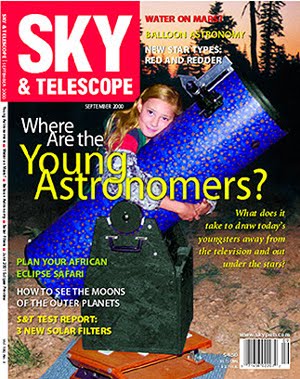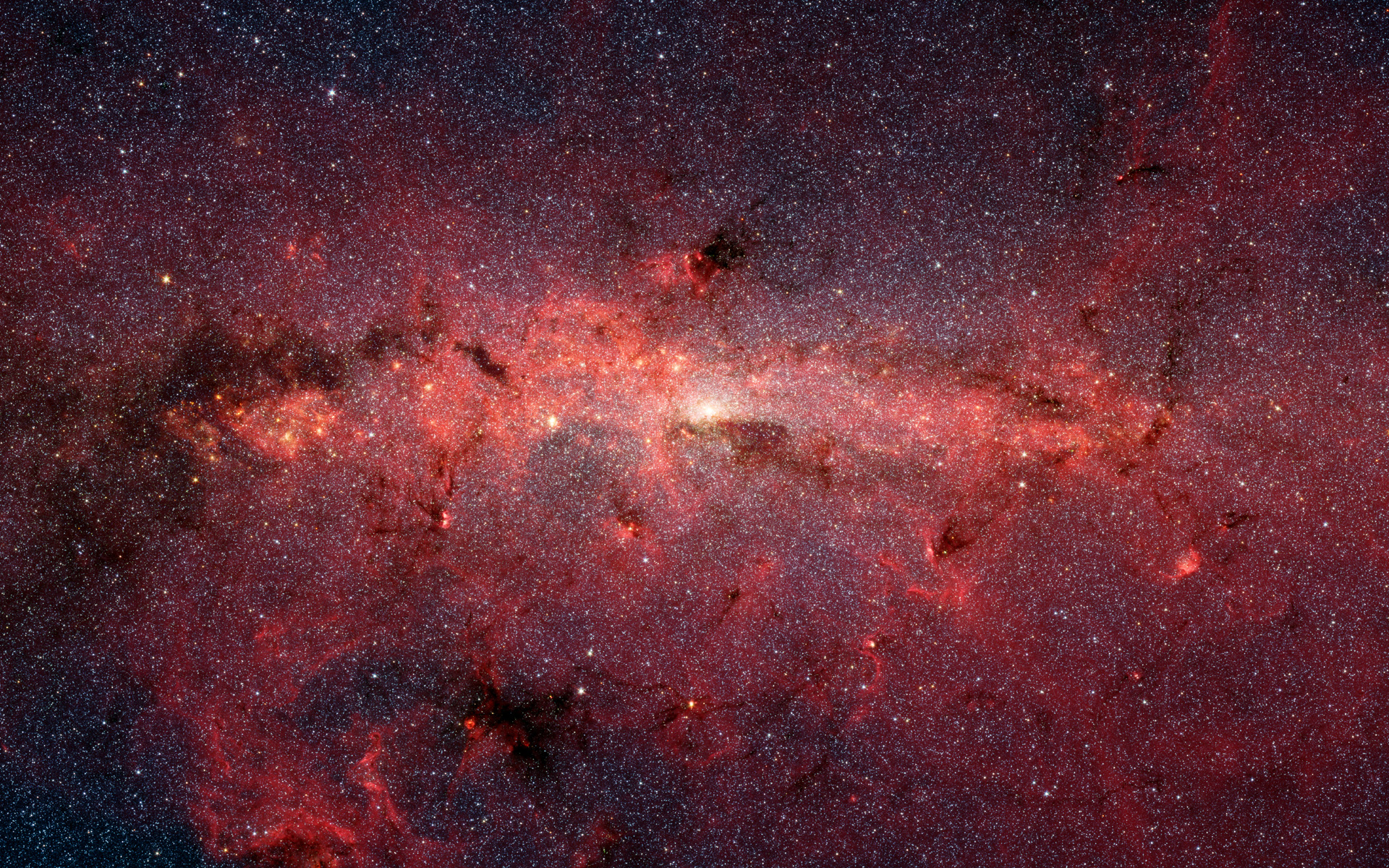I arrived at Montebello Regional Open Space Preserve, on the upper eastern slope of the Santa Cruz Mountains above Palo Alto California about an hour before sunset. I had not felt much like observing, since TAC's mailing list was unusually quiet for a day when some subscribers had said, just a day before, that they'd go observing on Wednesday night. No mention of observing on the list that day. I wondered how it might be to observe there alone, something I only do in my own backyard, but I thought this might be the first time at a remote site. However, when I pulled into the parking lot, there were several cars already positioned with telescopes on their south side. In fact, during the next few hours, we'd end up with 16 observers and almost as many telescopes set up.
In attendance were Peter Natscher (14.5" Starmaster Dob), Rashad Al-Mansour (12.5" Homebuilt Dob), Leonard Tramiel (C8), Alan Adler (8" Celestron Starhopper), Isaac Kikawada (Tele Vue Pronto), Rich Neuschaefer (6" AstroPhysics APO), Gerrit Kooi (14 x 100 binocs), John Gibson (C8), Bob Baldwin (6" Cass and Orion Shortube 80), Tom Moutoux (C8), David Kingsley (7" Starmaster Oak Classic), William Phelps (7" AstroPhysics APO) and Phil Reinders (Vixen 200mm reflector and Vixen 80mm refractor). I had a 14.5" f/5.6 Dob. During the evening, Jeff Crilly and Jay Freeman arrived and visited while mooching photons.
It was a very good turnout for a mid-week observing session. Amazing what a lousy winter and sudden good weather can do!
As one would expect, the two AP's spent most of the evening viewing Mars, while the Dobs were hunting various deep sky objects. During the night, between about 9 p.m. and 1 a.m. (when the moon peeked its brightness over the eastern horizon), I logged 35 galaxies on my observing list, in a very relaxed manner. I would look at objects in other people's scopes, walk around, talk, and in general take a very laid back approach to the night's observing. I will list the galaxies at the end of this report, and only give any detail on the most interesting view of the night.
The first pair of interesting object were not on my observing list. The first is NGC5139, a remarkable object called Omega Centauri. As the night wore on and the big globular cluster gained even a degree or two in elevation, the view became better and better. We must have had extremely steady and transparent skies, as the view was of thousands of pinpoint stars. All we could say was "wow!!" and "imagine the view from the southern hemisphere." After years of balking at looking at this object from the bay area, this view was well worth it. I had peeked at M3 while the sky was darkening, and the BIG one does not need to be afraid of any competition. This is an awe inspiring sight.
Just above Omega Centauri is NGC5128. This is the radio galaxy know as Centaurus A. While the galaxy was dim in comparison to the big globular, it was easy to see in my scope, Peter's and Rashad's that there was a dark area cutting right through the galaxy. The best view was in Rashad's 12.5" Dob... probably owing the combination of a moment of even more exceptional seeing and the right combination of object and eyepiece. It was fun to play with averted vision and note the large dark dust lane.
Most of my scheduled observing program took place in Leo, Leo Minor, Hydra and Sextans, the bulk of those being in the Leos. The first notable view was of NGC2964 and NGC2968, a pair of galaxies almost equal in size. These looked very much like twins, making a pleasing view. My star hop to this pair involved placing the western edge of my Telrad just about equidistant between 40-Alpha Lynx (the tail star of Lynx) and Rasalas in Leo's head, but a bit more toward Alpha Lynx. NGC2964 is mag 11.3 and the other shines at mag 12.8. This is an easy pair to observe.
NGC3115 in Sextans is a must see. When I first looked at it on my computer (I use a laptop in the field, rather than a paper chart), I thought "okay, an extended smudge... no big deal" and... the DSS image was not very encouraging. But... it is a beautiful bright spindle galaxy, nice well defined core and the edge-on spiral arms extending away into easy to see points. This one was a surprise! I found the galaxy by first going to the brightest star in Hydra... Alphard, at mag 2.6 (yes, it looks bright compared to the rest of the area). Following the constellation's figure toward the serpents tail, you next come to mag 3.6 41-Lambda Hydrae just over 11 degrees away. When you identify that star, place the Telrad such that it is north, with the eastern edge of the outer circle about 2 degrees north and one degree west of the star. This nice galaxy should be within a few eyepiece field's sweeps.
While NGC2964 and NGC2968 were about equal in size, NGC3169 and NGC3166 were equal in size *and* brightness. These two looked like twins two ways! Both galaxies are in the mid 11-mag range, both are about 4.5 x 2.5 arc-minutes in size. Just outside the field of my 20mm Nagler, I easily found NGC3156 at almost mag 13. Nice grouping! These galaxies took a bit more "luck" in star hopping (really, a misnomer, what I do is Telrad placement). Taking 30-Eta Leonis (the star just about Regulus leading up to the backward question mark), and drawing a line to and through Regulus, I placed the Telrad just under two full Telrad distances (about 5 degrees) south. It is almost a straight line, perhaps just a nudge east.
Being a galaxy observer, I always love getting multiple objects in one field. The area around NGC3190 is such a place. I think this is a well know group, given its easy to find location in Leo's "neck" ... between Algieba (the nice double star Gamma Leonis) and Adhafera (Zeta Leonis). NGC3190 is a nice spiral galaxy at mag 12, and good size at 4.3' x 1.5'. Just about 5' away, in the direction of equally bright stars at the edge of the field, sits NGC3193, a round galaxy also at mag 12. Now, going back toward 3190, and past it about twice the prior distance, you will see a dimmer galaxy, NGC3185, about half the size of 3190, shining at mag 12.7. The fourth galaxy was a serious challenge with averted vision. It is NGC3187 at mag 13.2, and forms almost a square with 3190, 3193, and a bright star off 3193. This one I could only occasionally glimpse, and could not detect much shape.
I will briefly mention NGC3226 and NGC3227 in Leo, as they are very close together and make an interesting image. Grab a look at the Digital Sky Survey to see what to expect. These are very easy to find, just off Algeiba by 1/2 degree.
NGC3344 is described in Software Bisque's _The_Sky_ as a round galaxy, but its DSS image shows it to be a beautiful face-on spiral 7 arc-minutes in diameter.
I liked the view of NGC3377 combined with NGC3377A in the same field. There was nothing particularly exciting about 3377, but the view of 3377A seemed to be ghostly in comparison. 3377 is a bright (mag 10.2) elongated galaxy, that shows on screen as larger than 3367. But, 3377A appears larger although it is not, and at mag 13.6 it is substantially dimmer. This one is an interesting view. You can also get NGC3367 in the field, at mag 12.1. A Telrad makes these galaxies a snap to get to. Look at Leo's tail stars... three of them. Take the northwest one (Chertan, Theta Leonis) as a starting point. Two line emanate from it, one toward Eta Leonis (which we visited before), the other to Rho Leonis, south east of Regulus. Using Chertan as the vertex of a widening angle, place the Telrad so it just touches the edge of both lines that extend toward Eta and Rho. You should be just about on NGC3377. Enjoy the view!
If you place the lower portion of the Telrad's inner 2 degree circle just about midpoint between Chertan and Rho Leonis, you should find a very nice grouping of three galaxies... NGC3379, NGC3384 and NGC3389. My notes called this a grouping of "big" galaxies. Two glow in the mag 10 range, the dimmer of the three is in the 12's. Easy to find, worth the trip.
Finally, I enjoyed looking at NGC3395, 3396, 3413, 3424 and 3430, all in the same field. This group is in Leo's little sibling, Leo Minor, just south of 46-Leonis Minoris. The stars of Leo Minor can be difficult to find, as there are no really bright ones in the area. But, with some study, one can distinguish the triangular shape of the constellation, beginning just west of the tail of Ursa Major (the stars Alula Borealis and Alula Australis). The star (46-Leonis Minoris) should be placed just outside the 2 degree Telrad circle to find these galaxies. NGC3395 and 3396 appear to be very close together. In fact, the DSS seems to show them as interacting. They are mag 12.2 and 12.6 respectively. Moving west toward a grouping of three bright stars, you will find NGC3430 (mag 12.05 and easy to see), NGC3424 (mag 13.18 and not too difficult), and along that line, but curving away from 3395/96, finally you can detect NGC3413 (dim at 13.08). This is a fun field to try getting some detail out of, and to view in context of he bright stars and various patterns.
It was a very good night observing. We also had some nice views of Mars (thanks to William and Rich for sharing their nice refractors), and then the moon rose. The conditions were quite nice, almost shirtsleeve weather by leaving time. The sky was bright by Montebello standards, but the transparency and steadiness made it very worthwhile. By 2 a.m. I was on my way home.
Here is a complete list of objects observed last night:
- NGC2811
- NGC2859
- NGC2964 & NGC2968
- NGC2974
- NGC3115
- NGC3166
- NGC3169 & NGC3156
- NGC3190, NGC3185, NGC3139, NGC3189
- NGC3198
- NGC3226
- NGC3227
- NGC3245
- NGC3277
- NGC3294
- NGC3344
- NGC3377, NCG3367
- NGC3379, NGC3384, NGC3389
- NGC3395, NGC3396, NGC3413, NGC3424, NGC3430
- NGC3412
- NGC3414
- NGC3432
- NGC3486
- NGC3489
- M3
- M104
- NGC4565
- NGC5128
- NGC5139
- Mars
- Venus
- Moon (naked eye)












No comments:
Post a Comment